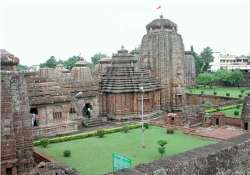Know why Bhubaneswar is called city of temples (watch pics)
Bhubaneswar: The capital of the eastern state of Odisha, Bhubaneswar has a history that stretches back to over 2000 years. It was the ancient capital of Kalinga, and Dhauli near Bhubaneswar is the place where

Bhubaneswar: The capital of the eastern state of Odisha, Bhubaneswar has a history that stretches back to over 2000 years.
It was the ancient capital of Kalinga, and Dhauli near Bhubaneswar is the place where the famous battle was fought between Emperor Ashoka and the Kalinga army, after which Ashoka followed Buddhism.
Bhubaneshwar, the 'city of temples', named after Tribhuvaneswar, 'Lord of Three Worlds', still preserves over 500 of India's finest temples, around which the religious life of the city revolves. Near Bhubaneswar are the famous Udaygiri and Khandigiri caves from the Jain period, which house the most ancient Indian theatre preserved till this day.
The word Bhubaneswar in its literal sense means the 'God's World' which showcases the walk down centuries of temple architecture.
Mythological references and the epigraphic sources describe the area as Ekamra Kshetra and Saiva Pitha.
In 1936, when Odisha became a separate province, carved out of Bengal and Bihar, Cuttack was its capital. A new capital was built in Bhubaneswar in 1956.
Together with Puri and Konark, Bhubaneswar forms the 'golden triangle', one of the most visited tourist destinations in East India, for its proud possession of magnificent sculpture and majestic architectural heritage.
Here are some of the world famous temples of Bhubaneswar:
1. Lingaraj Temple
Lingaraj Temple is believed to be the oldest and largest temple of Bhubaneshwar.
The term 'Lingaraj' suggests 'The king of Lingas', where 'Linga' is the phallic form of Lord Shiva.
In the 11th century, Lingaraj Temple was built by the King Jajati Keshari, who belonged to Soma dynasty.
It is said that when the King shifted his capital from Jaipur to Bhubaneshwar, he started the construction of Lingaraj Temple.
It was the ancient capital of Kalinga, and Dhauli near Bhubaneswar is the place where the famous battle was fought between Emperor Ashoka and the Kalinga army, after which Ashoka followed Buddhism.
Bhubaneshwar, the 'city of temples', named after Tribhuvaneswar, 'Lord of Three Worlds', still preserves over 500 of India's finest temples, around which the religious life of the city revolves. Near Bhubaneswar are the famous Udaygiri and Khandigiri caves from the Jain period, which house the most ancient Indian theatre preserved till this day.
The word Bhubaneswar in its literal sense means the 'God's World' which showcases the walk down centuries of temple architecture.
Mythological references and the epigraphic sources describe the area as Ekamra Kshetra and Saiva Pitha.
In 1936, when Odisha became a separate province, carved out of Bengal and Bihar, Cuttack was its capital. A new capital was built in Bhubaneswar in 1956.
Together with Puri and Konark, Bhubaneswar forms the 'golden triangle', one of the most visited tourist destinations in East India, for its proud possession of magnificent sculpture and majestic architectural heritage.
Here are some of the world famous temples of Bhubaneswar:
1. Lingaraj Temple
Lingaraj Temple is believed to be the oldest and largest temple of Bhubaneshwar.
The term 'Lingaraj' suggests 'The king of Lingas', where 'Linga' is the phallic form of Lord Shiva.
In the 11th century, Lingaraj Temple was built by the King Jajati Keshari, who belonged to Soma dynasty.
It is said that when the King shifted his capital from Jaipur to Bhubaneshwar, he started the construction of Lingaraj Temple.